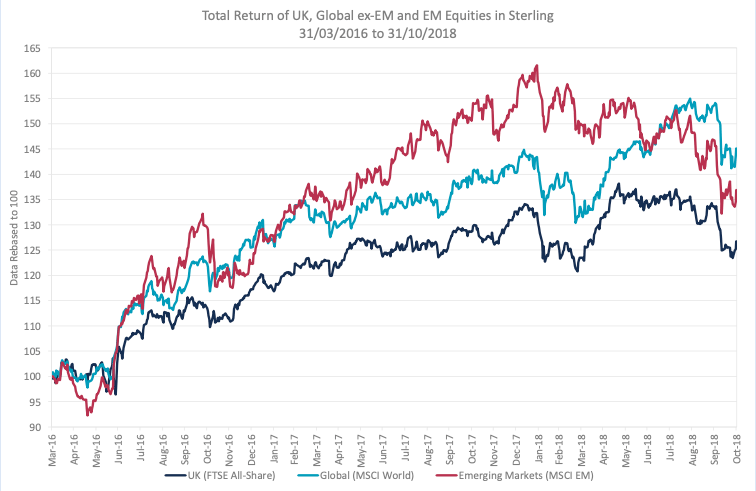
Significantly improved funding ratios in March 2019 valuations provide local government pension schemes with some interesting choices, says Karen Shackleton
There has been much discussion during LGPS committee meetings about anticipated improvements in funding positions at the next triennial valuation in March 2019.
Equity markets have performed strongly since March 2016, as shown in the chart below.
Despite a more volatile period in 2018 itself, a sterling investor has still seen their UK equities (black line) increase by over 26% since March 2016, with global equities (blue line) having risen by 45% and emerging markets (red line) by nearly 37% to 31 October 2018.
Source: Bloomberg
These favourable returns could have a dramatic impact on funding levels, with improvements in funding levels of 10%, or more being talked about.
Some funds could now find themselves in a fully funded or even a surplus position.
Following the favourable equity market returns to the end of December 2017, a number of LGPS pension funds decided to implement equity protection (option) strategies at the start of 2018, in order to try and lock in their improved funding ratios.
This involved them deciding on (a) the proportion of equities to hedge (b) which markets to protect (c) when the protection should kick in (the higher the level of protection required, the more expensive the option).
So a fund might have protected 50% of its global equity exposure from a fall in equities of greater than -5% but less than -30%.
It would then pay a premium for that protection, either as an up-front sum, or by giving up some of the upside should equity markets rise even further.
For a fund that implemented a protection strategy at the very start of the year, that would have helped this year, so far, with UK equities having fallen by over 4%, and emerging market equities having fallen by over 10% to end-October.
Time will tell as to whether these option strategies will have benefited schemes, by the time their actuarial valuations are finalised, and their new funding ratios are known, but they have certainly added more confidence around the likely outcomes.
If, as is hoped, LGPS funds do see significantly improved funding ratios in their March 2019 valuations, this will give them some interesting choices.
They might, for example, decide to de-risk their investment strategy, so as to ensure a smoother and more certain journey to full funding.
They might choose to reduce their deficit recovery period (i.e. reach a fully funded position sooner than the recovery plan that was approved in March 2016).
Alternatively, they might choose to reduce employer contributions (i.e. pay less for the same amount of time as agreed in the March 2016 recovery plan).
Clearly the last option has advantages, from a local authority budgeting perspective, and could be an attractive direction of travel for some funds, come March 2019.
De-risking
It is important to remember that all these decisions should be made with an eye on the cashflow profile of the pension fund.
A de-risking strategy might involve the fund moving out of equities into more secure-income style approaches, which are very likely to pay a higher yield than equities.
This could result in greater income being generated within the portfolio.
It would also be beneficial to a scheme approaching a negative cashflow position (defined here as the point when contributions are less than pensions being paid out), because the income could then be used to fund the net deficit.
Reducing the deficit recovery period would not have any immediate implication for the net cashflow of the pension fund, but once the fund has reached its fully funded status, there is likely to be a sharp drop in employer contributions. This would need to be factored into any future cashflow modelling.
Reducing employer contributions next year (but not changing the recovery period) would have a similar but more muted impact on the cashflow until the end of the recovery period, to the extent of the reduction, but the difference here, is that it would take immediate effect.
This would not only need to be factored into cashflow modelling, but it could also mean the pension fund needs to start drawing down its income immediately after the contribution rate drops.
This might mean a more urgent review of the underlying asset mix is required, to allow for a shift in the asset allocation towards income-generative assets.
Add into the mix the ongoing transition of funds’ assets to their LGPS pools, and it is fair to say that the next triennial valuation could result in some very interesting and diverse outcomes.
Karen Shackleton is senior adviser at MJ Allenbridge













